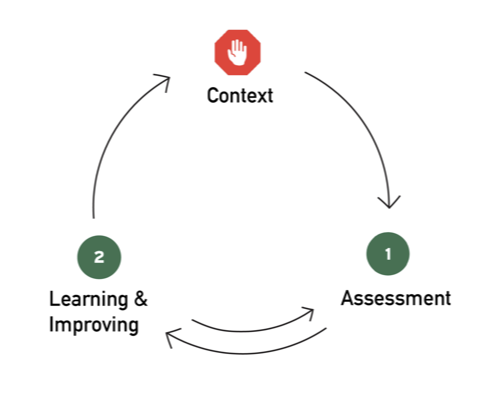Reversing climate change, finding cures to disease, ensuring no child goes hungry, reforming the criminal justice system in the U.S., improving mental health, advancing gender equity globally — these are just a few examples of the types of change donors are trying to affect. They reflect some of society’s most pressing challenges. No single cycle of grantmaking will succeed in accomplishing these goals. However, by establishing an ongoing cycle of assessment, learning, and improvement, you can accelerate progress toward greater social impact.

Context for Assessment
This ongoing cycle starts with understanding the intended social impact goals and approach of your philanthropic activity. All assessment activities need to be understood in the context of what was intended. While you may discover unintended consequences of your philanthropic activity — both good and bad — you cannot hold yourself or the organizations you support accountable for a goal or approach different from what was originally intended.
Assessment: A Two-fold Process
Assessment involves two kinds of comparisons. The first is comparing your actual activities to what you intended. The second is comparing your actual results to what you had hoped.
1. Actual versus intended activities
Once you have implemented philanthropic activities, you can now compare actual activities to intended activities. Questions to answer include:
- Did my activities match the plans I made?
- Did I fund the types of organizations and efforts I said I would?
- Did the amounts and timeframe for funding match what my grantees and I anticipated?
- Did my grantees’ activities match their plans and timing?
Answers to these questions are necessary before assessing actual results. If the answer to any of these questions is no, don’t be surprised if the actual results you and your grantees observe differ from what everyone expected.
2. Actual results versus hoped-for results
As in so many aspects of life, real-world results won’t perfectly match the expectations you or your grantees had. There is no tried-and-true recipe for social and environmental change. When assessing the results of your philanthropic activity, specific questions you need to answer include:
- Did my funding produce the expected result?
- If not, how did the results differ from what I hoped for?
- What might account for any differences between actual and expected results?
Any differences between actual and intended activities might account for a difference in results. However, faulty assumptions and unanticipated external factors — both good and bad — might also account for results that differ from expectations.
Learning and Improving
The answers you obtain from assessment activities provide valuable lessons for you, your grantees, and other stakeholders. Since no one donor, foundation, or nonprofit organization alone can create the kind of lasting social impact we all seek, asking and then sharing answers to these questions enable the next cycle of philanthropic activity to be that much more effective.
Questions to consider include:
- What have I learned that will help us accomplish more, better, faster, and in a way that positive gains endure?
- How will we adjust future efforts — including goal setting and choosing an approach — to incorporate what we’ve learned?
There are many books, publications, organizations, and consultants dedicated to assessing nonprofit and philanthropic performance — you will find many of these in the resources section of the Talent for Giving microsite at www.impact.upenn.edu/toolkits/talent-for-giving.
